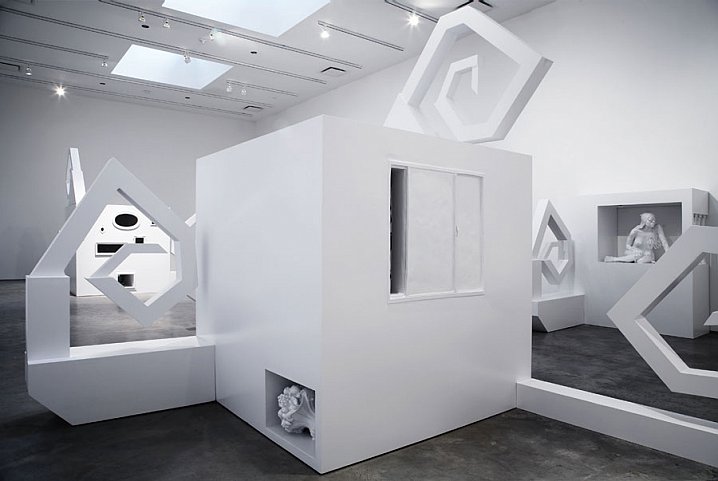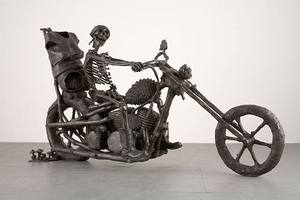This is an archive of the ArtCat Zine, 2007-2009. Please visit our new project, IDIOM.
Untitled Review For An Untitled Show: Liz Craft At Marianne Boesky
Liz Craft
Marianne Boesky Gallery - 509 W. 24th Street, New York NY
November 17 - December 22, 2007
I was introduced to Liz Craft's work in 2002, as a student in a graduate seminar, sitting at a conference table in a dark room, while a professor of mine was desperately trying to explain the importance of taking risks. She showed us a handful of shaky progress snapshots of this sculpture, which would become Death Rider (Virgo).
The viewing conditions were not ideal. The sculpture was half-shrouded in a blue tarp with tools and a gantry surrounding it, but it still blew my mind a little because it was totally cheesy and, more dangerously, palpably earnest (and yet I didn't hate it!). It took the bored, knowing head nod that contemporary artists are supposed to achieve and turned it inside out. Instead, this thing charged at my eyes and made my heart bulge against my shirt, because it was made with so much love. And it confused me because it was totally balls to the wall and, at the same time tame, traditional, and studded with cliches. It's a traditional bronze statue of a skeleton riding a motorcycle for chrissakes!
I decided in that moment that Liz Craft must be some sort of empathic genius.
The edge in Craft's work comes consistently from doing what artists should never, ever do. Instead of resisting artworld cliches like seventies stuff, unicorns, or what would become "Banks Violette Gothic," she charges into them. Instead of distancing herself from the language and materials of traditional sculpture, she depends upon them. Instead of relying on irony, she commits to a vision. The result is work that is fantastically fresh, but in no way "new." It's fresh because it's wrong; because it obviously delights in fights against art history and tradition, against cliche, against what sophisticated art viewers expect to see.
So it should not surprise you that I had expectations for this show that's currently up at Boesky. In fact, I thought I knew what I was going to write for this review before I even walked into the gallery. Instead, I am finding that I have to muddle through my hero worship to arrive at a place of opportunity. The show at Boesky is not very good; but at least it's not very good in ways that are meaningful to lovers of Liz Craft's tendency toward risk and helpful to risk-takers everywhere, who must know by now that it's no fun if you can't fail!
Craft's untitled show consists of large, medium, and small aluminum architectonic forms that are studded with windows, fireplaces, and other kinds of (mostly square) holes, which function to create inside and outside spaces. Inside these holes are cast interior spaces like flower vases or figures floating in water, also aluminum, welded to the larger architectonic forms. These are not mini-installations or assemblages. Everything is the same material and welded together, so each sculpture is a distinct spatial expression rather than a collection of relationships. Each piece is painted a supercool glossy white, and this emphasizes the tension between inside and outside. All of this makes the gallery, of course, into the largest of these container spaces; as time goes on you may well become aware that you, too, are inside a larger instance of these modeled spaces, the gallery enclosing you and the work in a Russian nesting-doll style configuration.
The effect is potentially interesting. You're walking around in a sea of squares that could evoke drywall architecture but are the wrong scale, are a little too small. You are constantly being drawn to look inside them, to see the giant palm tree, the girl with the seashell eyes, and so on. But these nice spatial moments are textbook, and the overall effect isn't intellectually rigorous — it's academic. The architectonic forms do not read as architecture or spaces so much as a Six Foot Cube with scorpion tails. The pockets of space do not work to carve out Craft's surrealist life-of-the-mind as much as they illustrate the idea that a sculpture exists in a space and has its own internal and external areas, which is, these days, almost dogmatically more important than the crafting of the thing itself. Basically, the show presents itself as a checklist of allegiances: not just Tony Smith, but Barbara Hepworth; Charles Ray; Rachel Harrison; Jennifer Pastor; Charles Long.
Liz Craft made an academically correct show that positions her tidily within a specific dialogue in contemporary sculpture. In the context of Chelsea, this is hardly shocking. We are at an academic apex in art history, the era of the MFA. We are all accustomed to artists framing themselves as good students with a clear sense of their relevancy to a larger dialogue. This impulse to be a good student creates a lot of art that is merely interesting or correct — art that's doing it right, and in this show, Craft is definitely doing it right.
On first glance, it is confounding that Liz Craft has succumbed to the conventions of this particular style. In my small circle, this show of right from the indisputable Queen of Wrong fueled speculation across a practical dimension — that perhaps Craft was spooked into making work that made more sense. And well, that's an easy answer, but I think that it's more interesting (and more fair to Craft) to look to the very nature of taking risks in the first place.
One of the reasons Craft's work tends to sing is because it pushes and pushes at exactly what happened at Boesky: it foists total safety on itself all the time. Bronze feels daring in Chelsea today, but really, it's safe — the safest. Your grandmother in Iowa knows what she is looking at when it's made of bronze. It's safe to take up skeletons or unicorns when others are doing so. It's not as safe as painting or anything, but it's safe for a sculptor to make objects that have inherent value and will last forever, and can therefore be easily commodified. It's safe to hide in your love of the making of the thing and trust that by loving the making of it everything will work out. It's safe to work with art school techniques and art history's lessons.
I have a feeling that Craft pushes herself into these “correct” positions and then busts out of them, or across them, by salaciously reveling in he making of the work itself, in making the smartest possible decisions within the stupidest possible framework. Within this system, the concept can be this supersafe amalgam of traditions and cliches, but in the making of the thing itself, each one of these traditions and cliches has to duke it out. The grand effect winds up not being dueling tropes at all. It winds up being about Craft's vision.
I know my take is just as speculative, but hey: at least it's across an artistic dimension. Craft is smart enough not to make such dry work, and has a history of serious risk-taking. So I look at this show and assume that her strategy includes busying her left brain with obstacles, doing anything that makes her say “oh my god this is going to suck” or “I can't do that, that's lame or too stupid!” so that her right brain is free to do its thing. And she seems, consistently, to get to these obstacles by clinging ferociously to in-jokes, tradition, and a formal training in sculpture.
This cold white body of work is, therefore, not really a departure. It's just that the Fun Button never got pressed. The actual making of the work never leapt over the obstacles of its conception. And so it remains a mere amalgam of ideas that never makes your heart leap, laugh out loud, or even wonder what is happening. The biggest drag, perhaps, is that in Chelsea, this body of work blends in so nicely. It looks so much like a world of work that refuses to risk anything in the first place. I want to tell you that when it comes to Liz Craft, I know better than that. Rather than conclude that Craft has done whatever we are calling "selling out" these days, I would rather see this show as evidence that the thing she's been catapulting herself over all these years is the safety of academicism and tradition itself.
Besides, truly talented artists like Craft learn from failure, so I am not heartbroken about this show. What I am doing is looking forward to what it will yield.
ZINE
HOME
TIPS / COMMENTS
CATEGORIES
CONTRIBUTORS
- Greg Afinogenov
- B. Blagojevic
- Adda Birnir
- Susannah Edelbaum
- Julie Fishkin
- Paddy Johnson
- Jessica Loudis
- Christopher Reiger
- Andrew Robinson
- Peter J. Russo
- Blythe Sheldon
- S.C.Squibb
- Hrag Vartanian


